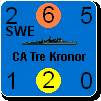Shannon V. OKeets
Posts: 22095
Joined: 5/19/2005
From: Honolulu, Hawaii
Status: offline

|
quote:
ORIGINAL: Dunckelzahn
This is beginning to look really good;)
Are you considering making the forrest, mountains etc. look less hexlike (like you done with rivers). You don't have to make individual bitmaps, just one for each border combination with plains in the background(which will be app. 50 different combinations:(
I think your math is off. Even after excluding ice, tundra, all sea, all lake, and Qattara depression, there are still 7 terrain types remaining. Pairwise combinations are 6 + 5 + 4 + 3 + 2 + 1 = 21. Which then have to be multiplied by the 6 hexsides (= 126).
That only addresses the problem of a hex of one terrain type adjacent to one of another terrain type. If you want two adjacent hexsides to look different than 2 single hexsides, then the problem is harder. For example, imagine where a vertex of 3 hexagons is for 3 different terrain types: forest, clear, and mountain. How is the area around the vertex drawn?
I am already pushing the limits of memory and CPU speed to render the map on the screen. Room for a lot more bitmaps doesn't exist. As it is already, there is a good chance I am gong to have to conjure up some more cleverness to accommodate all the river and coastal bitmaps once they are all finished. The European map (now completed) contains roughly 1/6 of the total.
Originally, I wanted some of what you suggested for the situations where a large swathe of one terrain type sits amidst a larger one of another. Pripet marshes come to mind. The problem is that to choose the correct alternative bitmap (e.g., for swamp) is a problem in and of itself. The alternative of hard coding which bitmap to use where is labor intensive too (about half of the 70,200 hexes are land).
So, what you see is what you are going to get - for the most part. To my mind, the general design for rendering the map is done.
_____________________________
Steve
Perfection is an elusive goal.
|
 Printable Version
Printable Version













 Give me a break.
Give me a break. I had 3 ideas for improving it when I got up this morning.
I had 3 ideas for improving it when I got up this morning.  If after a week it is still noticeable, then I'll start to worry.
If after a week it is still noticeable, then I'll start to worry. I write this stuff pretty close to stream of consciousness - I like to keep the people who bother to read this thread informed about the Good, the Bad, and the Ugly.
I write this stuff pretty close to stream of consciousness - I like to keep the people who bother to read this thread informed about the Good, the Bad, and the Ugly.










 New Messages
New Messages No New Messages
No New Messages Hot Topic w/ New Messages
Hot Topic w/ New Messages Hot Topic w/o New Messages
Hot Topic w/o New Messages Locked w/ New Messages
Locked w/ New Messages Locked w/o New Messages
Locked w/o New Messages Post New Thread
Post New Thread